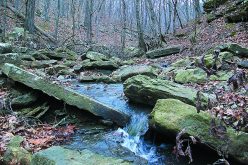‘Beautiful foxy squirrels’ fun to watch
AMANDA BANCROFT
Making Ripples
There are beautiful foxy squirrels scampering around Northwest Arkansas, but many people don’t get to see them. It’s too bad, because they’re such cuties and can be observed chilling on a walnut tree branch or walking across the grass. (Yes, they sometimes walk!) They’re common across their range, but they seem to show up less abundantly than the urban familiar, our grey squirrels. However, fox squirrels can thrive in urban areas, too, and are tolerant of human activity.
Fox squirrels (Sciurus niger) are the largest species of tree squirrels native to North America. This is one reason they spend more time foraging on the ground than other species and are somewhat less agile in trees, although they’re great climbers. They are heavier than the greys but can perform aerial acrobatics with the best of them.
The fox squirrel is a separate species and looks different from the red squirrel and the grey squirrel, but is often mistaken for one of these two. There are no red squirrels in Arkansas, so if you see an orange-colored squirrel, it’s probably a fox squirrel. Complicating things are the variety of coat colors the fox squirrel can have, with salt-and-pepper backs and orange bellies or completely black fur among their many varieties.

Photo courtesy Amanda Bancroft
There are no red squirrels in Arkansas, so if you see an orange-colored squirrel, it’s probably a fox squirrel.
They prefer more open oak-hickory forest without underbrush and savannah habitat filled with trees like walnut and pine. This gives them an ample supply of nut,s which they store in various caches for winter. They’re diurnal (active during the day) and non-territorial, although they can often be observed chasing other fox squirrels away from certain trees. They also consume fruits, grains, fungi, bird eggs, spring buds and insects when nuts aren’t available. Trees are their highways, cafeterias and homes. Squirrels build leaf nests, called dreys, when the weather is mild or hot. In winter, they may continue to use their leaf nests (as observed in Northwest Arkansas) but more commonly, they’ll snuggle into tree cavities, forks and dens. Both of these types of seasonal homes can be used to rear their young.
According to “Arkansas Mammals” by Sealander and Heidt, there are two breeding seasons. “The first season extends from late December or early January until mid-May, and the second extends from June to mid-October.” Baby fox squirrels arrive in the world from February through April, with second litters being born from June through October. They’re weaned between 12 and 14 weeks of age, but may be dependent on their mothers for 16 weeks. Although in captivity they can live up to 18 years, in the wild they live at most about a dozen years for females and a little over eight years for males.
Fox squirrels get their common name from one of their predators, the fox, which also has a bushy reddish tail like the squirrels. Squirrels use their tails like a blanket for insulation or as an umbrella in heavy rain. They also use various tail flicks, vocalizations and body language to communicate. If you spot a fox squirrel, take a few minutes to observe its behavior and appreciating their unique coats.
Amanda Bancroft is a writer, artist, and naturalist building an off-grid cottage for land conservation on Mt. Kessler. She and her husband Ryan blog about their adventures and offer a solar-hosted online educational center on how to make a difference with everyday choices at: www.RipplesBlog.org.










